Phosphorylation of Gli2 by protein kinase A is required for Gli2 processing and degradation and the Sonic Hedgehog-regulated mouse development
- PMID: 19056373
- PMCID: PMC2650378
- DOI: 10.1016/j.ydbio.2008.11.009
Phosphorylation of Gli2 by protein kinase A is required for Gli2 processing and degradation and the Sonic Hedgehog-regulated mouse development
Abstract
In mice, Gli2 and Gli3 are the transcription factors that mediate the initial Hedgehog (Hh) signaling. In the absence of Hh signaling, the majority of the full-length Gli3 protein undergoes proteolytic processing into a repressor, while only a small fraction of the full-length Gli2 protein is processed. Gli3 processing is dependent on phosphorylation of the first four of the six protein kinase A (PKA) sites at its C-terminus. However, whether the same phosphorylation of Gli2 by PKA is required for Gli2 processing and, if so, whether such phosphorylation regulates additional Gli2 function are unknown. To address these questions, we mutated these PKA sites in the mouse Gli2 locus to create the Gli2(P1-4) allele. Gli2(P1-4) homozygous embryos die in utero and exhibit exencephaly, defects in neural tube closure, enlarged craniofacial structures, and an extra anterior digit. Analysis of spinal cord patterning shows that domains of motoneurons and V2, V1, and V0 interneurons are expanded to different degrees in both Gli2(P1-4) single and Gli2(P1-4);Shh double mutants. Furthermore, Gli2(P1-4) expression prevents massive cell death and promotes cell proliferation in Shh mutant. Analysis of Gli2(P1-4) protein in vivo reveals that the mutant protein is not processed and is twice as stable as wild type Gli2 protein. We also show that the Gli2 repressor can effectively antagonize Gli2P1-4 activity. Together, these results indicate that phosphorylation of Gli2 by PKA induces Gli2 processing and destabilization in vivo and plays an important role in the Hh-regulated mouse embryonic patterning.
Figures
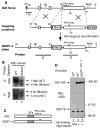
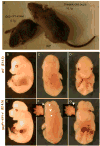


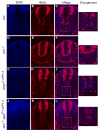
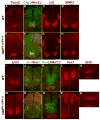
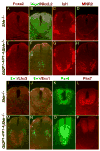


References
-
- Agren M, Kogerman P, Kleman MI, Wessling M, Toftgard R. Expression of the PTCH1 tumor suppressor gene is regulated by alternative promoters and a single functional Gli-binding site. Gene. 2004;330:101–14. - PubMed
-
- Aza-Blanc P, Ramirez-Weber FA, Laget MP, Schwartz C, Kornberg TB. Proteolysis that is inhibited by hedgehog targets Cubitus interruptus protein to the nucleus and converts it to a repressor. Cell. 1997;89:1043–53. - PubMed
-
- Bai CB, Auerbach W, Lee JS, Stephen D, Joyner AL. Gli2, but not Gli1, is required for initial Shh signaling and ectopic activation of the Shh pathway. Development. 2002;129:4753–4761. - PubMed
-
- Bai CB, Joyner AL. Gli1 can rescue the in vivo function of Gli2. Development. 2001;128:5161–5172. - PubMed
-
- Bai CB, Stephen D, Joyner AL. All mouse ventral spinal cord patterning by hedgehog is Gli dependent and involves an activator function of Gli3. Dev Cell. 2004;6:103–15. - PubMed
Publication types
MeSH terms
Substances
Grants and funding
LinkOut - more resources
Full Text Sources
Other Literature Sources
Molecular Biology Databases

